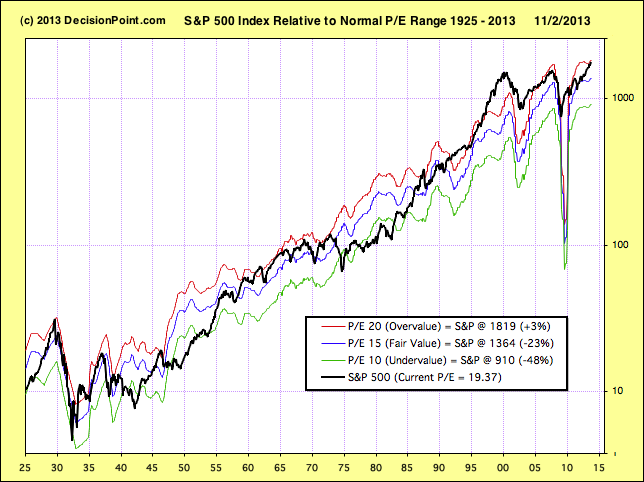As usual we are hearing many claims regarding market valuation, mostly that stocks are undervalued based upon future earnings projections. We are also seeing a lot of headlines about stocks being in a bubble. Using twelve-month trailing earnings for the S&P 500 Index, we find that stocks are overvalued, but not in a bubble.
The chart below shows the S&P 500 Index (black line) in relation to its normal P/E range. A P/E of 10 is undervalue, a P/E of 20 is overvalue, and a P/E of 15 is considered to be fair value. The chart is very long-term, beginning in the 1920s, and we can see that prices are generally contained within the undervalue/overvalue range, but they do occasionally move outside the range, presenting rare opportunities or periods of grave danger. The unusual down spike in 2009 is the result of Q4 2009 earnings being hammered by the financial crisis, when companies took the opportunity to clean up their balance sheets with the intent of improving future earnings.
Currently we see that prices have reached the top of the range and are therefore overvalued. While prices don't always turn down when they reach these levels, there is no question that stocks are clearly vulnerable to a corrective decline based upon valuation and historical performance. Are they in a bubble? Not based upon what we see on this chart. In 2000 prices were well above the normal range (with a P/E of 45!). Now that's a bubble.
All that is not to say that underlying problems are absent. It is true that prices are merely overvalued, but many assert that prices are being maintained artificially by the Fed's ongoing QE operations. I strongly recommend that you read Tom McClellan's latest article which contains a very compelling chart linking the current bull market to the Fed's efforts.
Conclusion: Based upon valuations alone, stock prices are vulnerable to correction or bear market, and the probability for QE tapering provides the trigger for beginning that decline.

